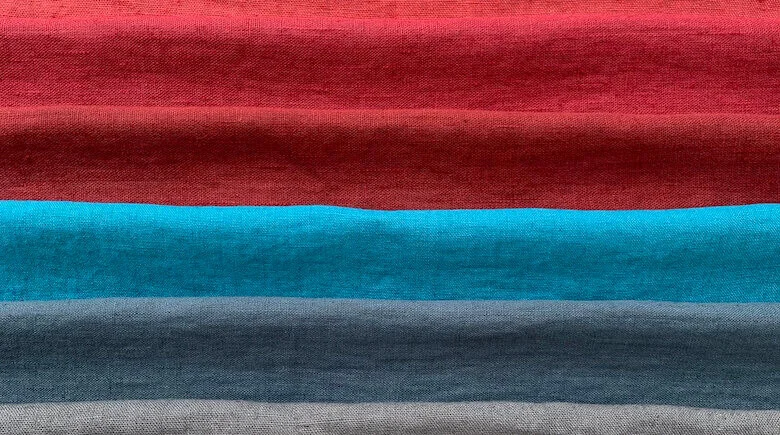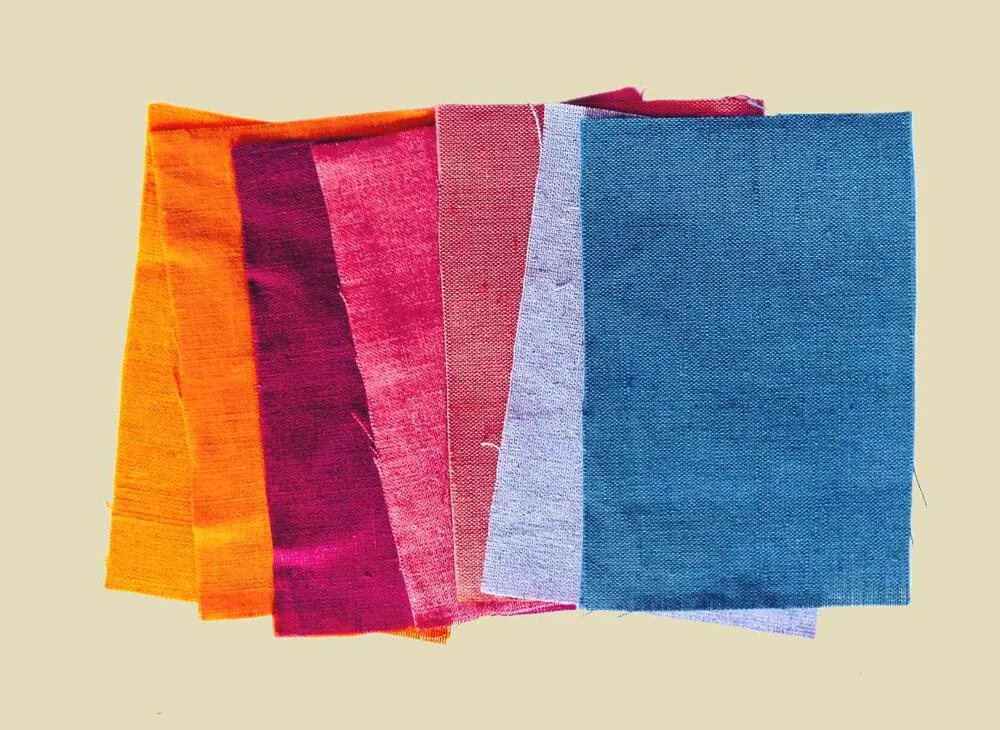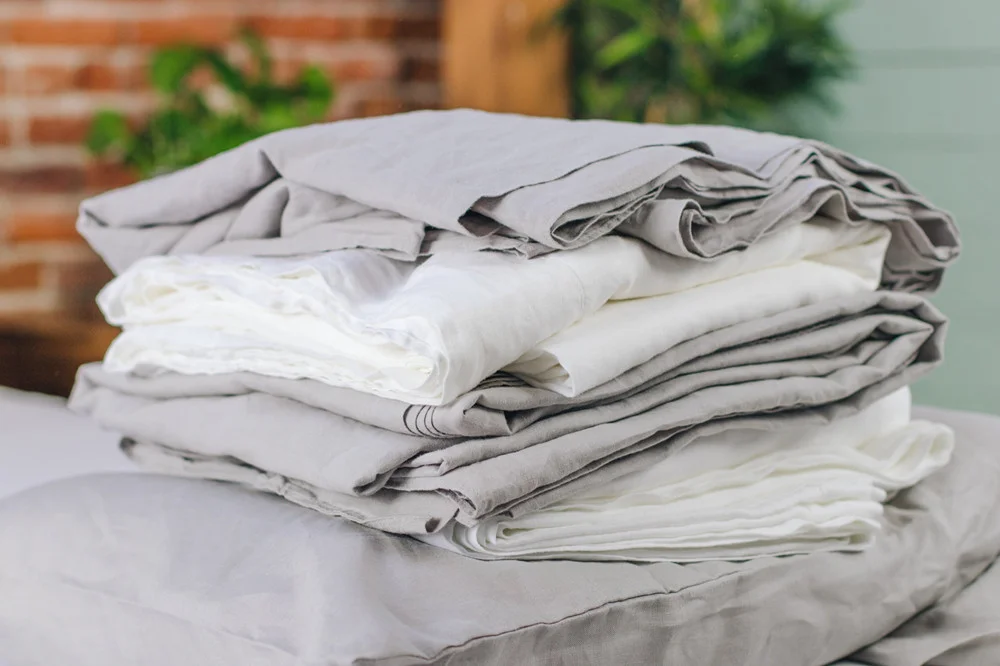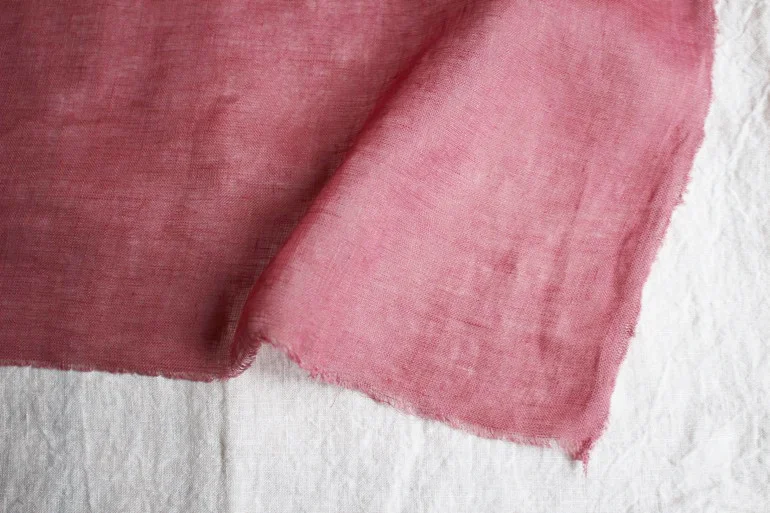Dyeing linen is straightforward and doesn’t pose significant challenges beyond the typical dye setup. The fabric is easy to handle and durable, so you don’t have to worry about damaging it during the process. Whether you use fiber-reactive dyes (the best option) or box dyes, you’ll end up with a beautifully dyed piece that will last for years!
What is Linen Fabric?
Linen fabric is a natural textile made from flax fibers, known for its durability, breathability, and eco-friendliness. Lightweight and strong, linen softens with use and is perfect for warm weather due to its ability to allow airflow and absorb moisture without feeling damp. Its natural texture, with a slightly wrinkled appearance, adds a relaxed charm to clothing and home textiles like sheets and towels. Additionally, linen is biodegradable and requires fewer resources to produce, making it a sustainable alternative to fabrics like cotton or polyester.

How To Dye Linen Fabric Using Fiber-Reactive Dye?
Fiber-reactive dyes are ideal for dyeing plant fibers like linen, making them a perfect match! While the stovetop method can yield quicker, more vibrant, and darker colors, it’s not essential for a successful linen dye project. You don’t need to purchase special equipment; a plastic bin or bucket will work just fine.
| Supplies | Description |
|---|---|
| Fiber-reactive dye | |
| Dye activators | Salt and Soda Ash |
| Dye pot | Made from non-reactive metal like aluminum, or a plastic bin or bucket |
| Rubber gloves | |
| Teaspoons | Set to be used only for dyeing (not for food) |
| Dust mask | |
| Mixing tools | Small plastic cup and stirring stick (e.g., plastic knife) |
| Stirring tools | Tongs, stirring spoon, or similar (heat-proof if using the stovetop method) |
| Optional | Kitchen scale (gram increments), mini scale (hundredths of gram increments), and a thermometer |
Step 1: Pre-wash And Dry Your Linen Fabric Or Garment
Pre-wash and dry your linen item using detergent. If dyeing an existing garment, treat any stains as they may absorb dye differently.
Step 2: Record The Weight Of Your Dry Item
Weigh the dry item and note its total weight.
Step 3: Calculate How Much Dye You Need
Refer to the dye’s suggested recipe, often given as a percentage of the item’s dry weight (e.g., “2% of Weight of Goods”). Calculate the required dye amount using the formula:
(Suggested percentage x Total dry weight) / 100\text{(Suggested percentage x Total dry weight) / 100}(Suggested percentage x Total dry weight) / 100. For example, if the item weighs 150g and you need 2% dye, the calculation is (2 x 150) / 100=3g\text{(2 x 150) / 100} = 3g(2 x 150) / 100=3g. Dark or vibrant colors may require more dye, such as 6%. Check the dye instructions.
To avoid manual calculations, use the Dharma Trading calculator, which provides dye quantities based on item weight and dye color.
Note: If you lack scales, you can estimate with tablespoons, though colors may not be exact.

Step 4: Mix Your Dye
Wear a dust mask before opening the dye jar, as powder dyes can irritate the lungs. Place the dye into a plastic cup and gradually add hot (not boiling) water, mixing until the dye forms a paste and then a liquid. If any granules remain undissolved, strain the liquid through muslin. Once the dye is fully dissolved and the jar is closed, you can remove the dust mask.
Step 5: Fill The Bucket With Enough Warm Or Hot Water For The Item
Place your item in the dye pot, ensuring there is enough water for it to move freely, and turn up the heat. Heat the water to between 54-60 degrees Celsius (130-150 Fahrenheit). Heating the water beyond this range won’t harm the linen as it might with silk or wool, and it also won’t affect the dye reaction, giving you some flexibility.
Step 6: Add The Dye Activator And Dye Solution
Add 3 to 9 tablespoons of salt per 450g of fabric, and 1.5 to 4.5 tablespoons of soda ash. Your selected dye may provide a more precise recommendation within this range, but typically, using more salt and soda ash results in a richer color. Use tongs or a spoon to move your fabric aside before pouring, ensuring the mixture is thoroughly combined.
Step 7: Add The Pre-mixed Dye
Once the salt and soda ash have dissolved, add the pre-mixed dye in the same careful manner—move the fabric aside or temporarily lift it out of the container to prevent direct pouring, which can cause uneven coloring. Thoroughly mix the dye into the bath. If needed, add a bit of extra hot water from your dye cup to ensure you’ve used all the dye.
Step 8: Stir Frequently
Using the stovetop method, maintain the temperature and stir the dye bath frequently until the dye is fully absorbed. Give special attention to the first 20 minutes, keeping the bath agitated and monitoring the temperature. After this initial period, reduce the heat and stir less frequently over the next few hours. For the bucket method, decrease stirring after the first hour and allow the item to soak for several hours or overnight.
Step 9: Remove Your Item And Rinse Until Water Runs Clear
Once the dye bath has cooled or after several hours (or overnight) for soaking, remove your linen item. Rinse it first under hot water, then cool water, until the water runs clear. Use a bit of hand soap during rinsing, especially with darker colors like black, ensuring all excess dye is removed to prevent future bleeding.
Step 10: Machine Wash Your Item
For thorough dye removal, consider running your item through a washing machine cycle after the sink rinse. A quick spin cycle can suffice. Once washed, your dyed linen is ready for use!
How To Dye Linen Fabric Sheets?
Dyeing linen sheets is fairly straightforward, with the main considerations focusing on the size of your sheet set rather than its fiber composition.
Before you start, ensure that your linen sheets consist of at least 80% linen or another plant-based fiber. Some brands mix linen with polyester, which can affect the dyeing outcome. Blends with cotton, viscose, or hemp will not impact the results since these fabrics use the same type of dye.
When dyeing large and bulky items like sheets, the key principle is to provide “enough room to move freely.” This instruction is crucial for the amount of water you add to your dyeing vessel, whether it’s a pot, bucket, or another container. The goal is to ensure the item absorbs dye evenly, without creating light or dark patches.

It’s essential to use a spacious vessel, such as a bathtub, to allow the sheets to spread out rather than being cramped (unless you prefer a scrunched-up, uneven look!). The key to achieving a consistent and even dye bath with large sheets is using a sufficiently large container that allows them to move freely while stirring.
Speaking of stirring, this is the second important factor. Your sheets require constant agitation throughout the dyeing process, especially during the initial half-hour. If you plan to leave the item to soak overnight, stir it continuously (using tongs, a wooden spoon, or hands protected by long dish gloves) for the first half-hour, and as frequently as possible thereafter.
A useful tip is to place the dyeing container in a location you frequently pass by, such as the kitchen counter, and stir it each time you walk past for the remainder of the day. Achieving an even dye bath on larger items like linen sheets requires some extra effort, but following these two steps—ensuring ample space for the sheets to move freely and stirring regularly—will yield beautiful results!
How To Dye Linen Fabric Naturally?
Linen is exceptionally well-suited to natural dyeing. It can endure extended periods submerged in water, withstand high temperatures and boiling effortlessly, and serve as an excellent canvas for vibrant natural dyes.
Natural dyeing encompasses a wide range of techniques involving mordants, dyestuffs, and processes, each varying greatly. However, linen adapts well to almost any approach. Begin by selecting a suitable dyestuff—perhaps exploring dye plants growing in your own backyard—and then choose a mordant compatible with plant fibers. We offer a comprehensive beginner’s guide to natural fabric dyeing.

Will The Dye Be Permanent?
Linen readily absorbs dye, producing wash-fast and colorfast results that are relatively permanent, assuming you’re using a non-fugitive dye. Fugitive dyes fade significantly when exposed to sunlight, heat, humidity, etc.
The longevity of your dyed fabric’s colors depends on how you care for it afterward. Exposure to sunlight and heat, including from drying in a dryer, can accelerate fading in any garment, regardless of dye type. In my experience, fiber-reactive dyes tend to offer more enduring results compared to box dyes.
Linen itself is a durable fiber, known for its longevity, so some fading over time is natural and adds character to the garment. To extend the lifespan of your linen item, wash it in cool water, air dry it in the shade on a clothesline, and store it away from direct sunlight.
FAQ
What Is Linen-Cotton Blends?
Linen-cotton blends combine the best of both fibers, offering a fabric that’s soft, breathable, and durable. These blends are comfortable, less prone to wrinkling than pure linen, and versatile for various uses. When dyeing, remember that the blend may absorb color differently, creating a unique look. Pre-wash and pre-treat the fabric for even dye absorption, and use fiber-reactive dyes for the best results.
Can You Dye Linen Fabric And Linen-Cotton Blends?
You can definitely dye linen! Since linen is derived from the fibrous leaves of the flax plant and is classified as a cellulose fiber, it can be dyed using fiber-reactive dyes. Cotton, being another cellulose fiber, will also take the same dyes that work on linen.
However, for animal fibers like wool and silk, or synthetics like polyester, different types of dyes are required, so blends containing these fibers may yield unpredictable results. To ensure you achieve your desired color, it’s best to dye a test swatch before dyeing the entire item.
Is It Easy to Dye Linen?
Linen is one of the easiest fibers to dye due to its ability to withstand high temperatures, its strength, and its resistance to tearing even when wet. Additionally, linen fabrics are often made with a plain, loose weave, allowing the dye to penetrate the fibers evenly. This makes linen an ideal fabric for beginners to work with, though it can sometimes be a costly material for practice.
What Is The Best Dye And Dyeing Method For Linen?
Fiber-reactive dyes are highly recommended for dyeing linen fibers. These dyes are specially formulated for plant fibers, such as linen (also known as cellulose fibers), and create a strong, vibrant, and permanent bond at a molecular level with the linen fibers.
Box dyes may include fiber-reactive dyes along with other types designed for various fabrics. However, they can be less effective due to lower concentrations of the specific dye needed for linen. Consequently, colors from box dyes may fade more quickly over time. Nevertheless, these dyes are convenient if you prioritize convenience over precise color outcomes.
Can You Dye Linen In Various Colors, Such As Black And White?
Dyeing linen in any color is quite straightforward, especially if you begin with a plain white fabric or garment. When dyeing over a colored garment, consider the color shift that will occur—for instance, dyeing a red linen shirt with blue dye will result in purple, not blue. Apart from this, there are virtually no limitations on the colors you can achieve!
For deep black shades, follow the specific instructions provided with your chosen black dye. Black dyes often require a higher concentration, sometimes double or quadruple the amount, and typically involve heat to achieve a rich, dark black.
If you have a colored linen garment or fabric and wish to dye it white, you’ll need to bleach rather than dye it. Linen is robust but can still be affected by bleach. Use a gentle approach—”low and slow”—with a diluted bleach solution and allow sufficient time for the process. Keep in mind that bleach may have slightly yellow fibers instead of achieving a pure white, so testing on a small area beforehand is advisable before treating the entire item.
Conclusion
In conclusion, “How to Dye Linen Fabric: The Ultimate Guide for Beginners” provides a comprehensive roadmap for achieving vibrant, durable results. By following the detailed steps on preparation, dye selection, and application, beginners can confidently transform linen fabric into personalized works of art. This guide not only imparts essential dyeing techniques but also encourages creative exploration, ensuring that each project is both enjoyable and successful for novice dyers.
